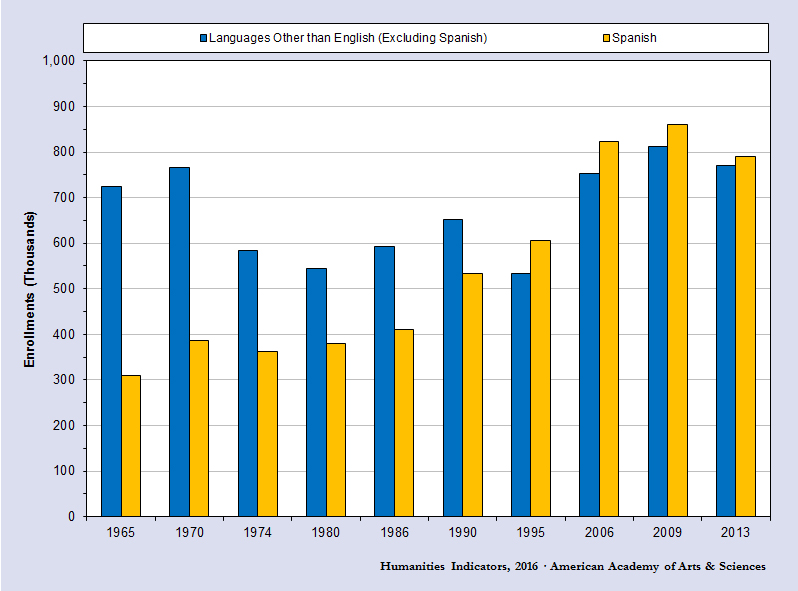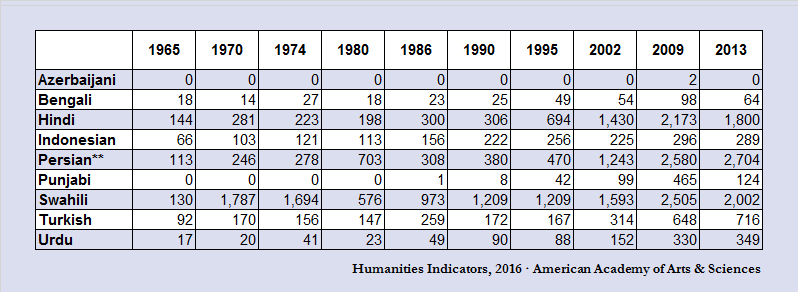Postsecondary Course-Taking in Languages Other than English
- The number of enrollments in postsecondary LOTE courses increased by more than half a million from 1965 to 2013, but the ratio of these enrollments to the total number of postsecondary students in 2013 was approximately half the level of five decades earlier, having fallen from 17.5 enrollments per 100 students to 8.3 per 100 (Indicator II-10a).1 The latter ratio represents an increase from the historic low of 7.7 per 100 in 1980 but a decrease of one enrollment per 100 from the recent peak in 2006.
- In 2013, Spanish and French were the languages most commonly taken by postsecondary students in American institutions of higher learning (as they have been since 1960), but with Spanish drawing approximately four times as many students as French (Indicator II-10b). These languages, along with German and Italian, each experienced an enrollment decline of 8% or more from 2009 to 2013.
- Enrollments in postsecondary Spanish classes increased to almost five times their 1960 level by 2009 (from 179,892 to 861,008) but then fell by over 70,000 by 2013. Enrollments in Italian also rose substantially over the 1960–2009 time period (increasing from 11,084 to a high of 80,322) but fell by more than 9,000 in the 2013 survey. Enrollments in both French and German, on the other hand, trended downward after 1965, reaching their lowest level on record in 2013 (down 47% and 59% respectively from their peak enrollments).
- After Spanish and French, American Sign Language (ASL) had the largest number of course enrollments in the 2013 survey (109,577), reflecting a continual rise from just 1,602 students in 1990.
- From 1995 to 2013, the number of students enrolled in Spanish was larger than enrollment in all other languages combined (Indicator II-10c). Spanish continues to draw the largest number of students by a wide margin, but the gap between Spanish enrollments and those in all other LOTE languages has narrowed since 1995—shrinking from a 14% difference to less than 3% in 2013.
- Enrollments in ancient Greek and Latin (once the foundation of a liberal arts education) are now considerably lower than enrollments in the modern languages. While enrollments in both subjects trended higher from the late 1990s through the mid-to-late 2000s, the number fell by more than 16% for Latin and 21% for Greek from 2009 to 2013 (Indicator II-10d). Total enrollments in these two classical languages were 4% of the combined enrollments in the three most-taken modern languages (American Sign Language, French, and Spanish) in 2013.
- Among those languages classified as “critical need” under the National Security Language Initiative, Chinese and Japanese have attracted the largest number of students in recent years (Indicator II-10e). 2More than 60,000 students enrolled in each of these languages in 2013, a number more than 18 times as high as in 1965. While enrollments in Japanese fell 8% from 2009 to 2013 (to 66,740 students), enrollments in Chinese increased 2% (to 61,055). The study of Korean also increased 45% over that time period, rising to 12,229 students, a substantial increase from the 1965 enrollment of 82 students.
- After Chinese and Japanese, the critical need language drawing the largest number of students in 2013 was Arabic (with 32,286 enrollments) despite a small decline in the most recent survey. After rising modestly from 1965 to 1995, enrollments increased sharply from the latter year (with 4,444 enrollments) to 2009 (34,908 enrollments).
- Among the critical need languages, only Russian had lower enrollments in 2013 than in 1965. The language experienced a sharp drop in enrollments after the collapse of the Soviet Union, and enrollments continued to decline in 2013, with 21,962 students enrolling in Russian language studies—the lowest level recorded.
- While their very low baseline values must be kept in mind, several of the less commonly taken other critical need languages on which the MLA collects data, including Persian, Swahili, and Urdu, experienced dramatic percentage growth over the 1965–2013 time period (Indicator II-10f). Despite the upward trajectory of the long-term trend, enrollments in several of these languages (including Azerbaijani, Bengali, Hindi, Indonesian, Punjabi, and Swahili) declined from 2009 to 2013.
Source: Modern Language Association (MLA), Language Enrollment Database, https://apps.mla.org/flsurvey_search, accessed 3/28/2016. For a description of the survey by which the MLA data were collected, see David Goldberg, Dennis Looney, and Natalia Lusin, Enrollments in Languages Other than English in United States Institutions of Higher Education, Fall 2013 (New York: Modern Language Association, Association of Departments of Foreign Languages, 2015).
The Modern Language Association started conducting enrollment surveys in 1958 but did not include Latin or ancient Greek until the 1965 survey. The tabulation here only extends back to 1965 to encompass all the languages currently tabulated in the survey.
* Data not collected prior to 1990.
Source: Modern Language Association (MLA), Language Enrollment Database, https://apps.mla.org/flsurvey_search, accessed 3/28/2016. For a description of the survey by which the MLA data were collected, see David Goldberg, Dennis Looney, and Natalia Lusin, Enrollments in Languages Other than English in United States Institutions of Higher Education, Fall 2013 (New York: Modern Language Association, Association of Departments of Foreign Languages, 2015).
II-10c: Postsecondary Enrollments in Spanish Courses Compared to Those in All Other Languages (Excluding English), Selected Years, 1965–2013

Source: Modern Language Association (MLA), Language Enrollment Database, https://apps.mla.org/flsurvey_search, accessed 3/28/2016. For a description of the survey by which the MLA data were collected, see David Goldberg, Dennis Looney, and Natalia Lusin, Enrollments in Languages Other than English in United States Institutions of Higher Education, Fall 2013 (New York: Modern Language Association, Association of Departments of Foreign Languages, 2015).
The Modern Language Association started conducting enrollment surveys in 1958 but did not include Latin or ancient Greek until the 1965 survey. The tabulation here only extends back to 1965 to encompass all the languages currently tabulated in the survey.
Source: Modern Language Association (MLA), Language Enrollment Database, https://apps.mla.org/flsurvey_search, accessed 3/28/2016. For a description of the survey by which the MLA data were collected, see David Goldberg, Dennis Looney, and Natalia Lusin, Enrollments in Languages Other than English in United States Institutions of Higher Education, Fall 2013 (New York: Modern Language Association, Association of Departments of Foreign Languages, 2015).
The Modern Language Association started conducting enrollment surveys in 1958 but did not include Latin or ancient Greek until the 1965 survey. The tabulation here only extends back to 1965 to encompass all the languages currently tabulated in the survey.
Source: Modern Language Association (MLA), Language Enrollment Database, https://apps.mla.org/enroll_data_comb, accessed 3/28/2016. For a description of the survey by which the MLA data were collected, see David Goldberg, Dennis Looney, and Natalia Lusin, Enrollments in Languages Other than English in United States Institutions of Higher Education, Fall 2013 (New York: Modern Language Association, Association of Departments of Foreign Languages, 2015).
This graph charts enrollment trends for the most commonly taken languages identified in 2006 by the George W. Bush administration as “critical need” from a national security standpoint.
II-10f: Postsecondary Enrollments in Less Commonly Taken “Critical Need” Language Courses,* 1965–2013

* As designated by the Critical Language Scholarship (CLS) Program of the U.S. Department of State. For a description of the program, see http://clscholarship.org/.
** Total of Dari, Farsi, and Tajik, per definition at CLS site: http://www.clscholarship.org/languages/persian.
Source: Modern Language Association (MLA), Language Enrollment Database, https://apps.mla.org/flsurvey_search, accessed 3/28/2016. For a description of the survey by which the MLA data were collected, see David Goldberg, Dennis Looney, and Natalia Lusin, Enrollments in Languages Other than English in United States Institutions of Higher Education, Fall 2013 (New York: Modern Language Association, Association of Departments of Foreign Languages, 2015).
This table charts enrollment trends for the most commonly taken languages identified in 2006 by the George W. Bush administration as “critical need” from a national security standpoint.

